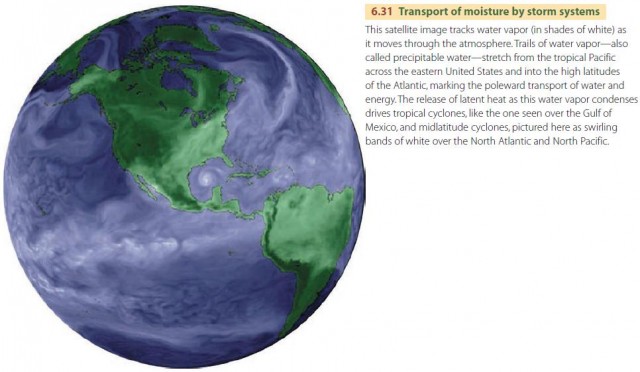Poleward Transport of Heat and Moisture
As we saw in Chapter 5, the general circulation of the atmosphere and oceans is driven by the difference in solar heating between low and high latitudes. This general circulation, combined with jet stream disturbances in the midlatitudes, serves to redistribute heat and moisture from the Equator to the poles in the process of poleward heat transport. Figure 6.30 shows the various mechanisms by which this heat and moisture redistribution takes place.
An important feature of this redistribution is the Hadley cell circulation—a global convection loop in which moist air converges and rises in the intertropical convergence zone (ITCZ) while subsiding and diverging in the subtropical high-pressure belts.

The Hadley cell convection loop acts to pump heat from warm equatorial oceans poleward to the subtropical zone. Near the surface, air flowing toward the ITCZ picks up water vapor evaporated by sunlight from warm ocean surfaces, increasing the moisture and latent heat content of the air. With convergence and uplift of the air at the ITCZ, the latent heat is converted to sensible heat as condensation occurs.
Air traveling poleward in the return circulation aloft retains much of this heat, although some is lost to space by radiant cooling. When the air descends in the subtropical high-pressure belts, the sensible heat becomes available at the surface. The net effect is to gather heat from tropical and equatorial zones and release the heat in the subtropical zone, where it can be conveyed farther poleward by jet stream disturbances into the midlatitudes.
In the mid- and high latitudes, poleward heat transport is produced almost exclusively by jet stream disturbances (Figure 6.31). Because the jet streams flow west to east, there can be no direct poleward transport of heat as in the Hadley cells. Instead, lobes of cold, dry polar or arctic air associated with growing jet stream disturbances plunge toward the Equator, while tongues of warmer, moister air originating in the subtropics flow toward the poles. Within these disturbances, cyclones also develop along the polar front, producing convergence of air at the surface. The subsequent uplift releases latent heat by condensation. Both of these processes provide a heat flow that warms the mid- and higher latitudes well beyond the insolation they receive.

Just as atmospheric circulation plays a role in moving heat from one region of the globe to another, so do oceanic circulations. How is this heat transported? Near the surface, the water in the low latitudes is exposed to intense insolation in the equatorial and tropical zones and is subsequently warmed. It is then transported by the western boundary currents, which bring warm, tropical waters to higher latitudes. As the water travels northward, it cools, losing heat and warming the atmosphere above it. The cooler waters then return south as part of the gyre circulation, where they cool the overlying atmosphere in the tropics.
Heat is also transported by the thermohaline circulation (Figure 6.32). By carrying warm surface water poleward, this loop acts like a heat pump in which sensible heat is acquired in tropical and equatorial regions and is moved northward into the North Atlantic, where it is transferred to the air. Since wind patterns move air eastward at higher latitudes, this heat ultimately warms Europe. The amount of heat released is quite large. A recent calculation shows that it is equal to about 35 percent of the total solar energy received by the Atlantic Ocean north of 40° latitude! This type of circulation does not occur in the Pacific or Indian Ocean, which is why Europe is significantly warmer than the highlatitude regions of the North Pacific and eastern North America at the same latitude.
